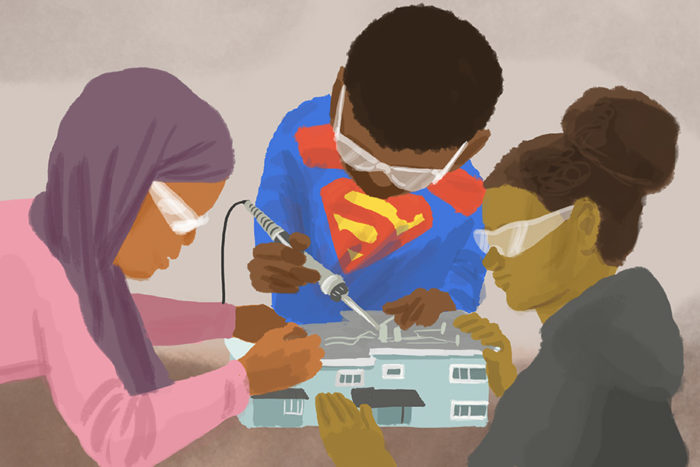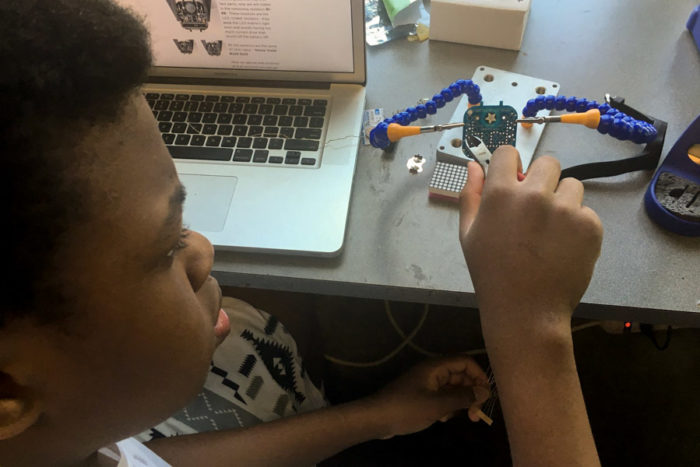
An after-school technology club at Yesler Community Center is struggling to survive the massive redevelopment project currently overhauling the neighborhood.
The Big-Brained Superheroes Club in Yesler Terrace became more than just a place for students to do homework, and evolved into a neighborhood STEM club where kids use “real-life superpowers” to solve science and technology problems and build “a kinder, nerdier, more imaginative world.”
But despite efforts by the Seattle Housing Authority (SHA) to keep existing low-income residents in the historic housing project, families are saying goodbye to the neighborhood — and that’s meant club members being forced to leave as well.
As the club’s Year-In-Review report noted, “2015 has been another Year of Adaptability for our young Big-Brained Superheroes in Yesler Terrace as their neighborhood gets demolished and friends and classmates slowly move away.“
Will the Housing Authority’s experiment in creating a mixed-income housing project really work for low-income families?
Will the Big-Brained Superheroes Club survive?
Using superpowers to solve problems
When Meredith Wenger was a volunteer at Yesler Community Center’s homework drop-in center back in 2011, she noticed pupils were just hanging around a lot, but not actually doing much homework. So she proposed a change.
Wenger, now the executive directive of the nonprofit club, says she’s just a “sidekick” to the Big-Brained Superheroes in the club (“Big Brains” for short). The club operates three days a week, with an average attendance of over 20 kids per day. There are as many as 120 pupils doing STE(A)M projects in the club each year.
Big Brains are encouraged to be not just scientific but also creative, thus the “A”, which stands for “arts” in STE(A)M. Their motto: “Tendimus. Discimus. Facimus.” is Latin for “We strive. We learn. We make.”
When I first volunteered as a sidekick/mentor back in March, I was instructed not to just give Big Brains solutions to problems, but instead prompt them to think about what superpower they can use when they are stuck.
Although the club doesn’t actively track how Big Brains are doing in school, Wenger has received feedback from both parents and students about improved performance. It’s as if good grades are side effects of the high engagement, attendance, cooperation and performance that happen in the club.
The Big Brains Club’s success seems to come from fostering what are known in the education business as “transformational academic mindsets,” which research shows are critical components of learning. In other words, students develop a sense of belonging, feel confident, and are willing to put in an effort and pursue deeper learning.
Since it started in 2012, Wenger and company have managed to do a lot. Students have presented their work in numerous STEM events, science fairs, and conventions including GeekGirlCon, Museum of Flight and Pacific Science Center and even in front of the Seattle City Council.
They organize their own events, too, like the National Week of Making portion of the Yesler Service Providers Collaborative’s Junenteenth Celebration. There they presented the visualization of the history of the Civil War through electric circuit, (they also made a pretty convincing the case that lightbulb was really invented by black man named Lewis Latimer, not Thomas Edison like we all thought).
The club isn’t without challenges. According to Wenger, there is shortage of sidekick volunteers. And they can only qualify for a few project-based grants because many science grant opportunities are too bureaucratic for such a small organization. Then there’s the ever-present threat being required to pay rent for the space in Yesler Community Center, which could be prohibitive for the resource-strapped Yesler Terrace families.
But the real challenge, Wenger explains, is keeping club members in the neighborhood.
The Big Brain drain
Ninth-grader Mohamud Mohammed has been going to the club since he was in fifth grade, later joined by his two younger siblings.
Mohamud is famous among friends of the club for developing a game using Arduino, an interactive programmable electronics hardware with open-source software platform. The project required him to wire a small motherboard to an LCD and then connect the motherboard to a computer and write the code for a game he designed himself. The result is a standalone LCD game console.
“It’s been lots of fun getting to know people, doing homework and building superpowers,” he said.
Mohamud says he likes the club because it has resources for students to be able “to do cool projects,” and lets the older kids help the younger kids with their homework and projects.

But in June, Mohamud’s family decided to relocate out of state. The Big Brains had a send off party for him and his siblings.
Wenger thinks the family’s move was spurred by the chaos that has been created since the Yesler Terrace Redevelopment Plan started.
And this is not an isolated case — she mentions other club members whose families have relocated. SHA officials admit that, despite their efforts to prioritize existing Yesler Terrace residents in the project, many don’t want move back in once construction is done.
Of the 200 plus residents who had to move out so far because their homes have been demolished, half declined the option to move back in to replacement units, according SHA Relocation Coordinator Sven Koehler. Many of them have already relocated out of state.
What is more, of those who initially said they wanted to move back in, only 27 had actually done so as of July.
Whether residents are still living in old houses or have moved out to make way for construction, to Koehler’s surprise only a few are willing to move in to new units — though he has said he’s observed a slight “upward desire” to accept their new houses recently.
“The kids don’t have a choice… they’re are not the ones making the decisions.”
For Wenger, it is not just the mass exodus that worries her about Big Brain’s future. It’s the social dynamics that mixed-income housing will create: hierarchies, isolation and disenfranchisement that will lead to conflicts. In these conflicts, she told me, she knows who is going to lose: the low-income, first-generation immigrant families that used to be the heart and soul of Yesler Terrace.
But Kerry Coughlin, SHA Communications Director, assured me there won’t be a problem of social/class tensions or affordability, based on SHA’s experiences from similar mixed-income projects in Rainier Vista, New Holly and High Point.
She told me the developers involved in Yesler Terrace project understand the value of diversity. So much so that Vulcan Inc., Paul Allen’s development company, is building a free community kitchen to spur positive social interaction.
A free space for nerds?
Will the Big Brained Superheroes Club stay free to participants too? So far, nobody can be sure. The Yesler Community Center, where it’s now housed, is operated by the Seattle Parks and Recreation Department, independent of SHA. Some in the department have wanted the club to pay at least partial rent to use the space, but have so far been assuaged by pleas and activism on the part of Big Brains advocates.
In theory, the club should have more advocates as the neighborhood transforms: The development is making room for 900,000 square feet of office space right on the edge of downtown that will likely become home to medical offices or a large tech firm.

As the the high-tech job market in Seattle has boomed, companies have taken a lot of heat for not hiring locally, instead bringing in transplants that driving up residential rents in once diverse neighborhoods.
Some of the high-tech companies are trying to alleviate this problem, but it hasn’t been easy in part due to so-called “achievement gap,” and local schools simply not producing qualified graduates.
STEM clubs like the Big Brains are a simple but effective way of directly addressing issue, encouraging young kids of color to focus on science and tech subjects. In fact, Google and Facebook have already helped in some of projects in the club, and Wenger’s husband, who works at Facebook, is a longtime sidekick.
But regardless, corporate support or financial concerns aren’t the biggest challenges facing the club now.
As wealthier families move in — and they’ll be the majority once the project is complete — Wenger fears three things will happen:
One, wealthier residents will offer to pay for services that are otherwise free, in search of quality or advantage. This will push out low-income residents.
Two, the target clientele of the club (low-income kids of color and immigrants) will be diluted by pupils coming from the dominant culture. Meredith recalled incidents at past science events where Big Brains have been taunted by students from other schools, and fears those same dynamics could come to the club itself.
Three, while some kids can adapt to changing, possibly threatening environments, their low-income first generation families may not.
“I think the kids can get used to [different environments], but in a safe way, as we do it in the Big Brains,” Wenger said. “I worry about the parents. The kids don’t have a choice… they’re are not the ones making the decisions.”
Wenger talks about the importance of kids and parents having a stable home as a safe space to adapt to changes going on around them.
“The parents are the big keys. And the social ties…are the things that are keeping them here.” Wenger said, “As the social ties fray, I suspect the linkages to their neighborhood are going to be minimized and they are going to take an easier path than say ‘I am in this to win this.’’’
Rather than feeling out of place in a huge housing development filled with wealthy residents and bordered by booming tech campus, they’ll just move somewhere else where they fit in better, as many Big Brains’ families already have.
Researchers at Vanderbilt University and University of Chicago share Wenger’s concerns. As an article in Cityscape, a policy research journal of the U.S. Department of Housing and Urban Development, wrote:
“Mixed-income neighborhoods are not a panacea [to poverty]. At worst, they may exacerbate inequality and operate as a veiled mechanism for gentrification that disproportionately benefits the middle-income households and relocates — and re-segregates — the poor. At best, they are a potentially useful but limited option in the face of complicated problems that American society has yet to find the political will to tackle more comprehensively.”
We can hope those “complicated problems” of American society will be solved sooner rather than later.
But we can also submit to reality and some of our worst gut feelings, partially shared by the researchers: that gentrification is like death — inevitable.
This article has been updated since it was first published.

